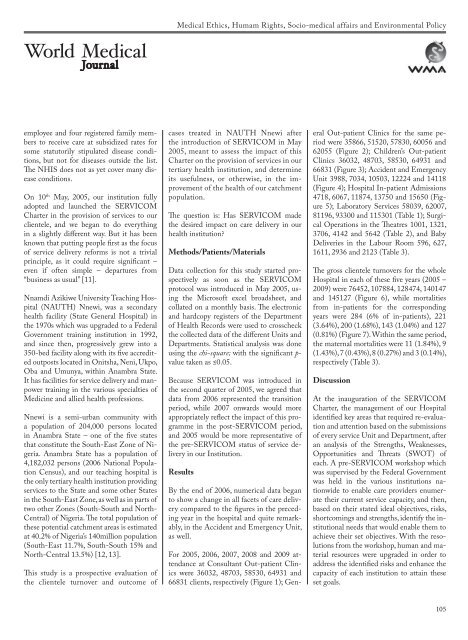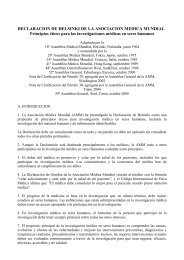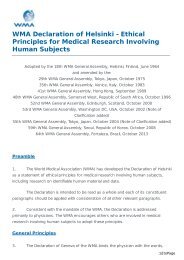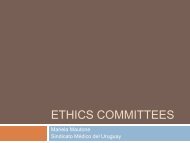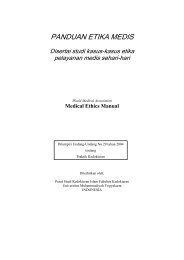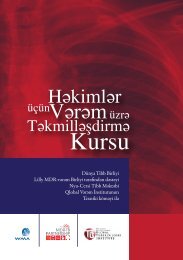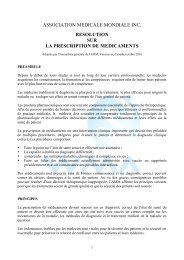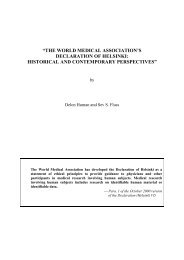WMJ 03 2010 - World Medical Association
WMJ 03 2010 - World Medical Association
WMJ 03 2010 - World Medical Association
- No tags were found...
Create successful ePaper yourself
Turn your PDF publications into a flip-book with our unique Google optimized e-Paper software.
<strong>Medical</strong> Ethics, Humam Rights, Socio-medical affairs and Environmental Policy<br />
employee and four registered family members<br />
to receive care at subsidized rates for<br />
some statutorily stipulated disease conditions,<br />
but not for diseases outside the list.<br />
The NHIS does not as yet cover many disease<br />
conditions.<br />
On 10 th May, 2005, our institution fully<br />
adopted and launched the SERVICOM<br />
Charter in the provision of services to our<br />
clientele, and we began to do everything<br />
in a slightly different way. But it has been<br />
known that putting people first as the focus<br />
of service delivery reforms is not a trivial<br />
principle, as it could require significant –<br />
even if often simple – departures from<br />
“business as usual” [11].<br />
Nnamdi Azikiwe University Teaching Hospital<br />
(NAUTH) Nnewi, was a secondary<br />
health facility (State General Hospital) in<br />
the 1970s which was upgraded to a Federal<br />
Government training institution in 1992,<br />
and since then, progressively grew into a<br />
350-bed facility along with its five accredited<br />
outposts located in Onitsha, Neni, Ukpo,<br />
Oba and Umunya, within Anambra State.<br />
It has facilities for service delivery and manpower<br />
training in the various specialties of<br />
Medicine and allied health professions.<br />
Nnewi is a semi-urban community with<br />
a population of 204,000 persons located<br />
in Anambra State – one of the five states<br />
that constitute the South-East Zone of Nigeria.<br />
Anambra State has a population of<br />
4,182,<strong>03</strong>2 persons (2006 National Population<br />
Census), and our teaching hospital is<br />
the only tertiary health institution providing<br />
services to the State and some other States<br />
in the South-East Zone, as well as in parts of<br />
two other Zones (South-South and North-<br />
Central) of Nigeria. The total population of<br />
these potential catchment areas is estimated<br />
at 40.2% of Nigeria’s 140million population<br />
(South-East 11.7%, South-South 15% and<br />
North-Central 13.5%) [12, 13].<br />
This study is a prospective evaluation of<br />
the clientele turnover and outcome of<br />
cases treated in NAUTH Nnewi after<br />
the introduction of SERVICOM in May<br />
2005, meant to assess the impact of this<br />
Charter on the provision of services in our<br />
tertiary health institution, and determine<br />
its usefulness, or otherwise, in the improvement<br />
of the health of our catchment<br />
population.<br />
The question is: Has SERVICOM made<br />
the desired impact on care delivery in our<br />
health institution<br />
Methods/Patients/Materials<br />
Data collection for this study started prospectively<br />
as soon as the SERVICOM<br />
protocol was introduced in May 2005, using<br />
the Microsoft excel broadsheet, and<br />
collated on a monthly basis. The electronic<br />
and hardcopy registers of the Department<br />
of Health Records were used to crosscheck<br />
the collected data of the different Units and<br />
Departments. Statistical analysis was done<br />
using the chi-square; with the significant p-<br />
value taken as ≤0.05.<br />
Because SERVICOM was introduced in<br />
the second quarter of 2005, we agreed that<br />
data from 2006 represented the transition<br />
period, while 2007 onwards would more<br />
appropriately reflect the impact of this programme<br />
in the post-SERVICOM period,<br />
and 2005 would be more representative of<br />
the pre-SERVICOM status of service delivery<br />
in our Institution.<br />
Results<br />
By the end of 2006, numerical data began<br />
to show a change in all facets of care delivery<br />
compared to the figures in the preceding<br />
year in the hospital and quite remarkably,<br />
in the Accident and Emergency Unit,<br />
as well.<br />
For 2005, 2006, 2007, 2008 and 2009 attendance<br />
at Consultant Out-patient Clinics<br />
were 36<strong>03</strong>2, 487<strong>03</strong>, 58530, 64931 and<br />
66831 clients, respectively (Figure 1); General<br />
Out-patient Clinics for the same period<br />
were 35866, 51520, 57830, 60056 and<br />
62055 (Figure 2); Children’s Out-patient<br />
Clinics 36<strong>03</strong>2, 487<strong>03</strong>, 58530, 64931 and<br />
66831 (Figure 3); Accident and Emergency<br />
Unit 3988, 7<strong>03</strong>4, 105<strong>03</strong>, 12224 and 14118<br />
(Figure 4); Hospital In-patient Admissions<br />
4718, 6067, 11874, 13750 and 15650 (Figure<br />
5); Laboratory Services 58<strong>03</strong>9, 62007,<br />
81196, 93300 and 115301 (Table 1); Surgical<br />
Operations in the Theatres 1001, 1321,<br />
3706, 4142 and 5642 (Table 2), and Baby<br />
Deliveries in the Labour Room 596, 627,<br />
1611, 2936 and 2123 (Table 3).<br />
The gross clientele turnovers for the whole<br />
Hospital in each of these five years (2005 –<br />
2009) were 76452, 107884, 128474, 140147<br />
and 145127 (Figure 6), while mortalities<br />
from in-patients for the corresponding<br />
years were 284 (6% of in-patients), 221<br />
(3.64%), 200 (1.68%), 143 (1.04%) and 127<br />
(0.81%) (Figure 7). Within the same period,<br />
the maternal mortalities were 11 (1.84%), 9<br />
(1.43%), 7 (0.43%), 8 (0.27%) and 3 (0.14%),<br />
respectively (Table 3).<br />
Discussion<br />
At the inauguration of the SERVICOM<br />
Charter, the management of our Hospital<br />
identified key areas that required re-evaluation<br />
and attention based on the submissions<br />
of every service Unit and Department, after<br />
an analysis of the Strengths, Weaknesses,<br />
Opportunities and Threats (SWOT) of<br />
each. A pre-SERVICOM workshop which<br />
was supervised by the Federal Government<br />
was held in the various institutions nationwide<br />
to enable care providers enumerate<br />
their current service capacity, and then,<br />
based on their stated ideal objectives, risks,<br />
shortcomings and strengths, identify the institutional<br />
needs that would enable them to<br />
achieve their set objectives. With the resolutions<br />
from the workshop, human and material<br />
resources were upgraded in order to<br />
address the identified risks and enhance the<br />
capacity of each institution to attain these<br />
set goals.<br />
105


